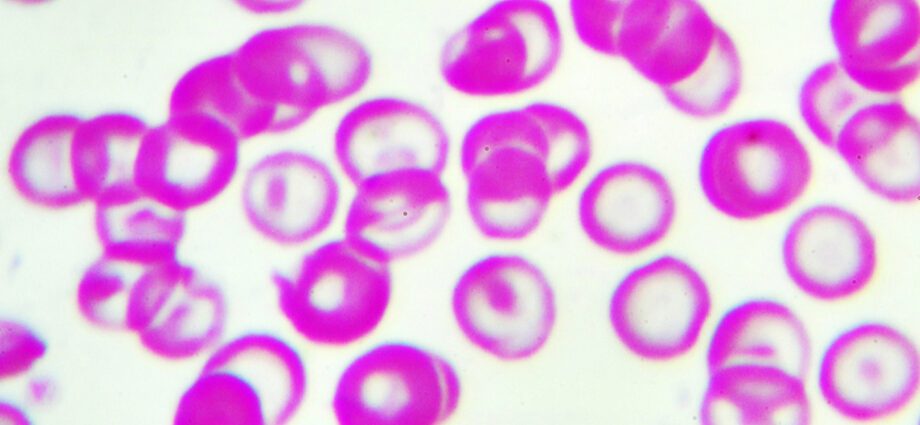Hypochromia: definition, symptoms, treatments
Hypochromia is a medical term for loss of color in an organ, tissue or cells. It can in particular be used in dermatology to qualify hypochromic skin spots or in hematology to designate hypochromic red blood cells.
What is hypochromia in dermatology?
In dermatology, hypochromia is a term used to refer to a loss of pigmentation in integuments such as the skin, hair and body hair. It can also be used to qualify a loss of color in the eyes.
What is the cause of tissue hypochromia?
Hypochromia is caused by a lack of melanin, a natural pigment produced by melanocytes within the body and responsible for the color of the skin, hair, body hair and eyes. Hypochromia can thus be caused by a defect in the production of melanin or a destruction of this pigment.
Lack of melanin can have many origins. It may in particular be due to an infection, an autoimmune disease or a genetic disease. Among the causes of hypochromia in dermatology, we find for example:
- theoculocutaneous albinism, characterized by a total absence of melanin in the skin, hair, body hair and eyes;
- partial albinism or piebaldism which, unlike oculocutaneous albinism, affects only the skin and hair;
- le vitiligo, an autoimmune disease which causes a progressive disappearance of melanocytes, cells at the origin of the synthesis of melanin;
- thehypopituitarisme, characterized by an arrest of hormonal secretions from the anterior pituitary which can lead to depigmentation of the integuments and mucous membranes;
- le pityriasis versicolor, a mycosis which can result in the appearance of hypopigmented spots, also called hypochromic skin spots.
How to treat hypochromia in dermatology?
The management of hypochromia depends on the diagnosis of the dermatologist. In the event of mycosis, anti-infective treatments can, for example, be implemented. In some cases, there is currently no treatment available. Preventive measures are nevertheless recommended to limit the development of depigmentation. Prevention involves protecting the skin, hair and eyes against ultraviolet (UV) rays.
What is hypochromia of red blood cells?
In hematology, hypochromia is a medical term that can be used to refer to an abnormality in the red blood cells (red blood cells). We speak of hypochromia of the red blood cells when they appear abnormally pale during an examination by the staining method of May-Grünwald Giemsa. Red blood cells are then called hypochromes.
What is the cause of hypochromic red blood cells?
The pallor of the red blood cells indicates a lack of hemoglobin. Indeed, hemoglobin is the element within red blood cells which gives them their famous red color. It is also the protein responsible for transporting oxygen within the body, hence the importance of rapid management of hypochromia of red blood cells.
In medicine, this hemoglobin deficiency is called hypochromic anemia. It is characterized by an abnormally low level of hemoglobin in the blood. Hypochromic anemia can have many causes including:
- iron deficiency (iron deficiency anemia), a trace element that contributes to the synthesis of hemoglobin;
- an inherited genetic defect, such as thalassemia.
How to detect hypochromic anemia?
Hypochromic red blood cells can be observed with the May-Grünwald Giemsa stain. Using different reagents, this method differentiates different populations of blood cells within a blood sample. This coloring makes it possible in particular to identify red blood cells, or red blood cells, which are recognizable by their red color. When these blood cells appear abnormally pale, it is called hypochromia of the red blood cells.
Hypochromic anemia is often diagnosed by measuring two blood parameters:
- the mean corpuscular hemoglobin content (TCMH), which measures the amount of hemoglobin contained in a red blood cell;
- the mean corpuscular hemoglobin concentration (CCMH), which corresponds to the mean hemoglobin concentration per red cell.
We speak of hypochromia of red blood cells in the following cases:
- TCMH less than 27 µg per cell;
- of CCMH less than 32 g / dL.
What is the management of hypochromic anemia?
Treatment of hypochromic anemia depends on its origin and course. Depending on the case, hemoglobin deficiency can for example be treated with iron supplementation or blood transfusion.
In more severe cases, a bone marrow transplant may be necessary.










